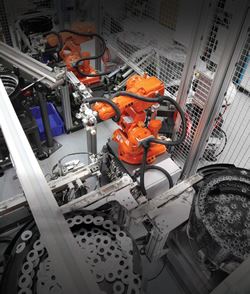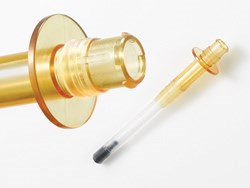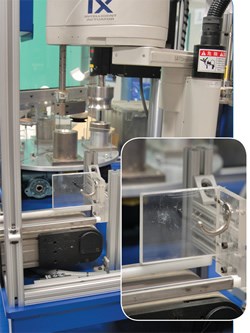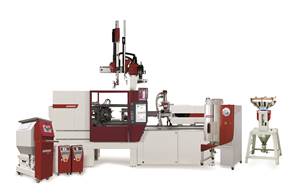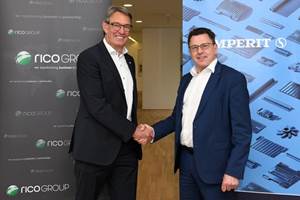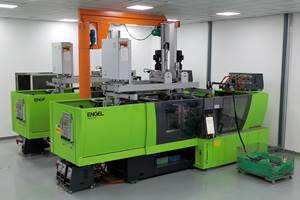Refine, Redesign, Retool: Re-engineering as a Business Model
It’s an unusual business model: “We take existing products or manufacturing processes and try to make them better.
It’s an unusual business model: “We take existing products or manufacturing processes and try to make them better. We refine and rethink them for better cost and reliability and quality.” That model has worked well for Dymotek (Dynamic Molding Technologies) in Ellington, Conn. “We are always looking for creative solutions,” continues Victor Morando, v.p. of engineering services. The owners are two brothers, Thomas and Steven Trueb, who started the company in 1991 to make a clever product they invented, a flexible PVC covering for under-sink pipes to prevent injury to people in wheelchairs. They sold that Truebro product line to a plumbing company in 2005 but continued to manufacture it on a custom basis.
To complete the transition from proprietary to custom molding, Dymotek built a 20,000-ft2 addition to the plant. “It was almost empty four years ago,” says Normand Forest, exec. v.p. and general manager. Now it has eight presses (five Arburg and three Toyo machines) in integrated molding cells with robots, automated QC testing, assembly, in-cavity process monitoring, and ERP production monitoring. The five newest presses are from Arburg Inc. (arburg.us).
In total, Dymotek (dymotek.com) has 19 presses from 35 to 400 tons and employs 55 on a six-day basis. With about $10 million annual revenues, it serves a variety of industries from medical to automotive. “We don’t want to concentrate on any one industry,” says Forest. One of its specialties, however, is liquid silicone (LSR) molding. “We want to see this business get bigger. There’s a lack of knowledge of the material and why to use it.”
“We’re a very science and technology oriented company,” adds Morando. “We use a lot of automation. We send our people to many technical conferences. We travel the world looking for the best technology.” As an example, he notes that Dymotek has worked with three Austrian moldmakers reputed to be the best in the world for LSR tools: Elmet (elmet.com, U.S. office in Kentland, Ind.), Rico Elastomere (rico.at), and Hefner Elastomere-Technik (now out of business). Dymotek also uses LSR metering/pumping systems from Elmet and Fluid Automation (fluidautomation.com).
QUALITY IN, COST OUT
An example of how Dymotek improves products and processes is a keychain-sized LED flashlight. It consists of polycarbonate and TPE components that were originally molded in separate tools and assembled. When Dymotek re-engineered the job, it became two-shot overmolding in one Arburg press with vertical and horizontal injectors into a rotating tool.
Another example where multi-shot overmolding (also on an Arburg press) reduced product costs and improved quality was the case of the Bump Pump for an automatic coffee dispensing system from Nestle Professional Vitality. Working together, NPV and Dymotek re-engineered the manufacturing process from what would have taken five tools down to two—one for a polystyrene insert and one for two-shot overmolding of Ultem polyetherimide from SABIC Innovative Plastics (sabic-ip.com) with LSR from Momentive Performance Materials (momentive.com). Because Ultem molds at a high temperature of 180 C/356 F, the residual heat of the part helps cure the silicone and produce a secure bond. To further enhance bonding, the Ultem part is exposed to UV light in the mold before the LSR is injected at two places onto the Ultem. The entire cycle is only 46.3 sec. That saved more than 2 min compared with an alternate concept using polycarbonate instead of Ultem. Although Ultem costs more than PC, Ultem’s higher processing temperature speeds curing of the silicone. After molding, the parts are subjected to 100% function testing with the aid of robots.
In these cases, overmolding in one press improved cost and quality when it replaced separate molding and assembly, but Dymotek sometimes goes in the other direction to achieve such results. Take the case of a one-way air valve. The part originally had a TPE membrane seal overmolded onto a polypropylene guide. The problem was a 30% reject rate caused by compression set of the TPE. Dymotek’s solution was to replace the TPE with more expensive but higher performing LSR. Dymotek first tried to overmold the LSR onto nylon and failed to get a functional seal due to the radical shrinkage difference between the materials. So Dymotek eliminated the need to overmold onto a rigid guide component by designing the guide function into the ABS cap. The LSR membrane is assembled with the ABS cap and body using ultrasonic welding. Improved quality more than compensated for increased materials and processing costs, according to QA manager Frank Fasano. After welding, robotic automation is used to test each product and laser print a date code on it.
This project illustrates the resourcefulness of Dymotek’s engineers in another way. While they explore sophisticated materials, processing, and design technologies, they’re not afraid to employ decidedly low-tech solutions where they fit. In the air-valve cell, all that impressive automation relies on a humble coat hook to flip the ABS valve body into the correct orientation for the conveyor to carry it to the labeling and laser engraving station (photo at right).
Dymotek even overhauled its own previous system for molding flexible PVC protective coverings. The molding cell has two Arburg presses and two ABB six-axis robots, which demold the very flexible product while maintaining registration of the part for a post-mold assembly operation. In that assembly, 22 nylon fasteners are assembled into the product by the same robots used for demolding. The job now requires one person for two presses instead of four. In this job, quality is overseen by an eDart cavity-pressure monitor from RJG Inc., Traverse City, Mich. (rjginc.com). “We never get flash or a short shot,” says Fasano. “If the eDart detects a bad part it rejects the part before assembly. If the eDart detected three bad parts it would shut down the cell.”
CLEAN AND FAST
Another element of efficiency is minimum inventories. “We run Just in Time, with very little warehouse inventory—from order to ship in three days,” adds Morando. This is accomplished with the aid of an ERP system from IQMS, Paso Robles, Calif. (iqms.com).
Because many of its products can be affected by dust contamination, Dymotek focuses on cleanliness in its shop. The company has a program to eliminate all wood pallets and cardboard for internal products, and no forklifts are allowed in the molding area—overhead cranes and special pallet rollers are used instead.
Related Content
IMM Cells Display Communications, Energy Measurement and Energy Recovery
NPE2024: Wittmann is featuring five injection molding machines incorporating its range of robotics and auxiliaries, with all products employing industry 4.0 communications, energy measurement and a brand-new red color.
Read MoreSemperit Acquires Rico Group
The global maker of specialized polymer products for industrial applications, including hoses and belts, has purchased the Austrian headquartered liquid silicone rubber molder and moldmaker.
Read MorePartnership Augments LSR Molding Simulation
SIGMA Engineering and Momentive Performance Materials announced a cooperation to optimize material data for silicone elastomers to make LSR molding simulation more reliable.
Read MoreDatwyler Expands O-Ring Production
The company has added injection molding machines to production sites in Mexico and China to boost production.
Read MoreRead Next
See Recyclers Close the Loop on Trade Show Production Scrap at NPE2024
A collaboration between show organizer PLASTICS, recycler CPR and size reduction experts WEIMA and Conair recovered and recycled all production scrap at NPE2024.
Read MoreLead the Conversation, Change the Conversation
Coverage of single-use plastics can be both misleading and demoralizing. Here are 10 tips for changing the perception of the plastics industry at your company and in your community.
Read MoreBeyond Prototypes: 8 Ways the Plastics Industry Is Using 3D Printing
Plastics processors are finding applications for 3D printing around the plant and across the supply chain. Here are 8 examples to look for at NPE2024.
Read More




